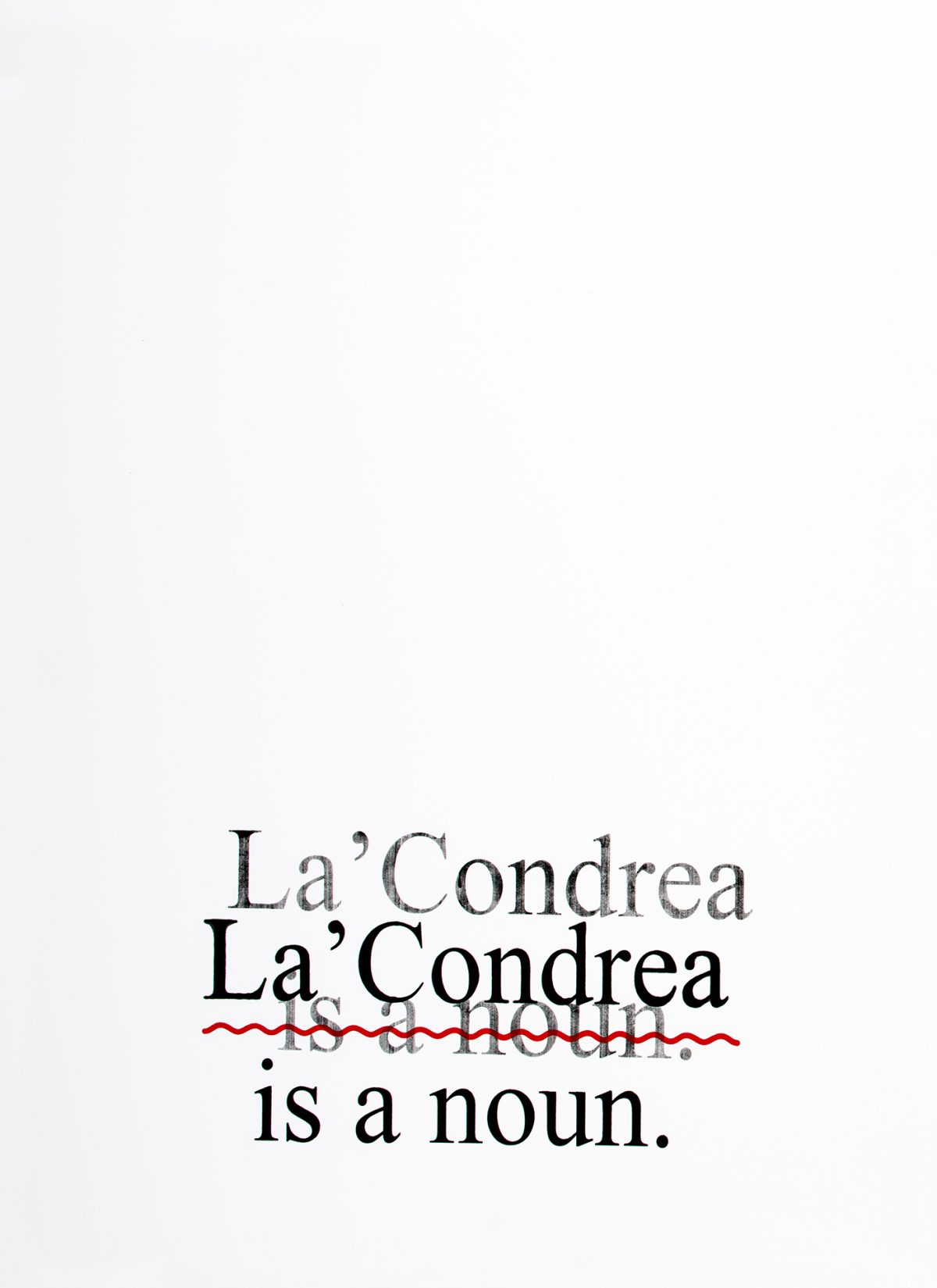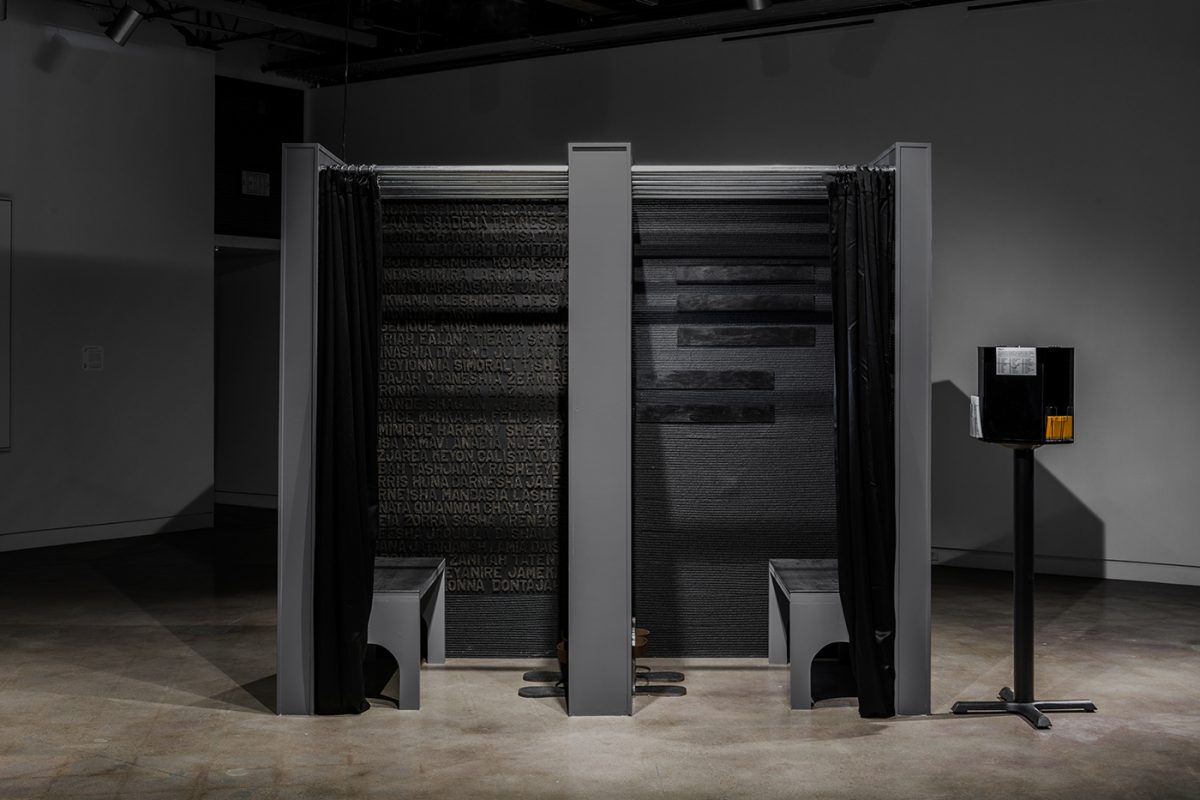
Through collage, artist Deborah Roberts examines the destructive ways that narrow definitions of beauty shape our self-image. In I’m, her latest exhibition at the Contemporary Austin, this simple contraction becomes a prompt and a proclamation that guides the relationship between the viewer and Roberts’ subjects. Her practice specifically explores the psychological burdens that Black children bear by being made invisible in some spaces but hyper-visible in others; in her latest work Roberts expresses themes of adultification, identity, gender, and violence, using coded symbols she incorporates into her images of youth.
Roberts deconstructs and reconstructs images of Black boys and girls using composites of carefully selected facial features. She combines these with painted body parts that include strong fists, flexed biceps, and outstretched arms. Her primary subjects are little girls whose colorful, mixed print clothing is paired with Roberts’ signature elements, like a red boxing glove, which boldly proclaims their strength while maintaining their youthful innocence.
Every detail within her collages is considered, and each component builds upon the next to express complex themes of visibility, gender, and self-actualization. Her latest works feature boys who are decidedly more carefree than her earlier renderings. In her 2018 Nessun Dorma series, Roberts evokes the memory of George Stinney Jr., who was horrifically executed at 14 years old in 1944. While this previous work renders the devastating consequences of Jim Crow racism on children, her latest collages foregrounds Black boy joy while asking important questions about the societal forces that actively thwart it.

Deborah Roberts, “Little man, little man” (2020), Installation view, Collage printed on weather-resistant vinyl, Dimensions variable. (Artwork © Deborah Roberts. Courtesy the artist; Vielmetter Los Angeles; and Stephen Friedman Gallery, London. Image courtesy the Contemporary Austin. Photograph by Colin Doyle)
“Little man, little man” (2020), a spirited large-scale outdoor mural in front of the museum, shares its name with a children’s book authored by James Baldwin and, features six exuberant young boys celebrating life through play and dance.
“Black boys are not given the opportunity to be as vulnerable as we know they are,” says Roberts in a recent interview with Hyperallergic. “These kids are going to grow up to be men. Let’s treat them as kids, let’s give them everything we can give them to be respectable citizens instead of just automatically thinking they’re up to no good.”
While Roberts gives these young boys the space to be free, she knows they are equally vulnerable to an adultification bias that strips them of their youth and threatens their freedom from an early age. This is a reality that many Black children must circumnavigate, where normal rites of passage become obstructed.

“Like the third grader who’s hard to deal with and is labeled ‘difficult,’” explains Roberts, “for the rest of his education he’s seen as someone different. If you have to constantly fight these stereotypes and labels that are put on you, you tend to give up.”
When James Baldwin originally published Little Man, Little Man in 1976, it was intended to be a children’s book for adults — one that allows the reader to see themselves in literature while also depicting the mature circumstances that surround some Black children. Inspired by Baldwin’s four-year-old nephew Tejan “TJ” Karefa-Smart, Little Man, Little Man depicts a day in the lives of three children in Harlem. Baldwin doesn’t hide what these children witness; hints of alcoholism, drug abuse, and mental illness are woven into the complex tapestry of their lived experiences.The story also manages to meet the reader where they are, whether it is a child longing for a reflection of themselves in print or an adult who seeks a deeper understanding of the circumstances reflected on the page.
Roberts operates in the same vein. The viewer’s gaze is simply a byproduct of their lived experience. In I’m, the artist creates a space for self-reflection through an immersive installation that resembles a hybrid between a memorial and a confessional booth. “What I’m trying to do is to try to say, ‘Come in, there’s medicine behind these bright colors’, says Roberts. “There’s a lot here to unpack if you’re willing to do the work.”
Two connected enclosures at the Contemporary Austin display the names of over 400 Black women and girls who have been reported missing and whose stories are largely unreported in the media. Their names are rendered in relief and constructed from black felt and discarded hair that appear to emerge from the jet black walls. Inside the booth, a recorded voice plays from a speaker: one man describes a Black child, and one woman describes a white girl. The incendiary language of the male gaze reveals the racist perceptions that catalyzes violence against Black children, specifically Black girls. The title of the piece, What If? (2021), asks viewers a question that Roberts doesn’t hesitate to answer: “I promise you, if 400 white women had gone missing, that would be on CNN, MSNBC and Fox News.”

While Roberts chose 400 names of missing women and girls, there are so many more whose whereabouts remain unknown. “We don’t know what happens to these women, and this should be national news.” While the sinister script plays within the small confessional, the viewer faces a mirror, prompting them to reflect on their own acts of contrition within the booth and outside the installation in the form of an anonymous comment box. While it is a piece that encourages absolution, it’s a risky proposition that’s fraught with resistance; people don’t like to admit their role in perpetuating racist structures.
“We know that there are people who are not going to recognize themselves and what I’m trying to say here,” says the artist. “I’m hoping that somewhere along the line, I’m able to reach someone who will understand their place in this and try to change.”
Roberts models this process within her own work, suggesting that in order to grow, you have to destroy that which is familiar. Perceptions are built on familiar stereotypes, biases, and prejudices that influence how we see and construct mental images. In order to reconstruct the image, you must first unpack the baggage that image is saddled with. “All the faces start with a beautiful, innocent child that I have destroyed in order for you to see that. All this stuff that history has placed on him — society, contemporary, pop culture — all this is placed on the body of an eight-year-old and in the face of a 10-year-old. And we have to enter the world like that.“

The artist’s text-based works are among her favorites. They are deceptively simple, yet contain a layered subtext that expands the artist’s interrogation of perception. In these prints, Roberts examines the vernacular of social acceptability, using a red wavy spell check line as a typographical proxy for the gaze. Roberts’ latest work pairs the underlined names of Black women with statements that challenge the implicit biases that perceive them as atypical. “La’Condrea is a noun” (2021) is a piece that level-sets the expectations of the viewer by transforming the symbol from indicating a typographic error to an assertive underscore — in doing so, Roberts claims the name’s rightful place both on the page and within the gallery.
“It’s so important that these girls and women who carry these names, these historical names, these American names that ought to be in these prestigious white cube spaces,” says Roberts. When her text based works are in conversation with her paintings, they emphatically pronounce her subject’s presence. “I’m asking you to see them, and the multiplicity of faces to find that one. They’re always looking directly at you. .When we make eye contact with people we recognize them as humans — that’s why the eyes are so important.”
Roberts creates work that’s situated in two experiential realms: one that allows us to see ourselves and another that envisages the freedom to be our whole selves. In I’m, the viewer fills in the space after the title; whether they are validated or challenged is entirely up to them.

Deborah Roberts, “Fighting all the ISM” (2019), Mixed media collage on canvas, 72×60 inches. (Artwork © Deborah Roberts. Courtesy the artist; Vielmetter Los Angeles; and Stephen Friedman Gallery, London. Image courtesy the Contemporary Austin. Photograph by Paul Bardagjy.)
Deborah Roberts: I’m continues at the Contemporary Austin Jones Center (700 Congress Avenue, Austin, TX 78701) through August 15.


0 Commentaires